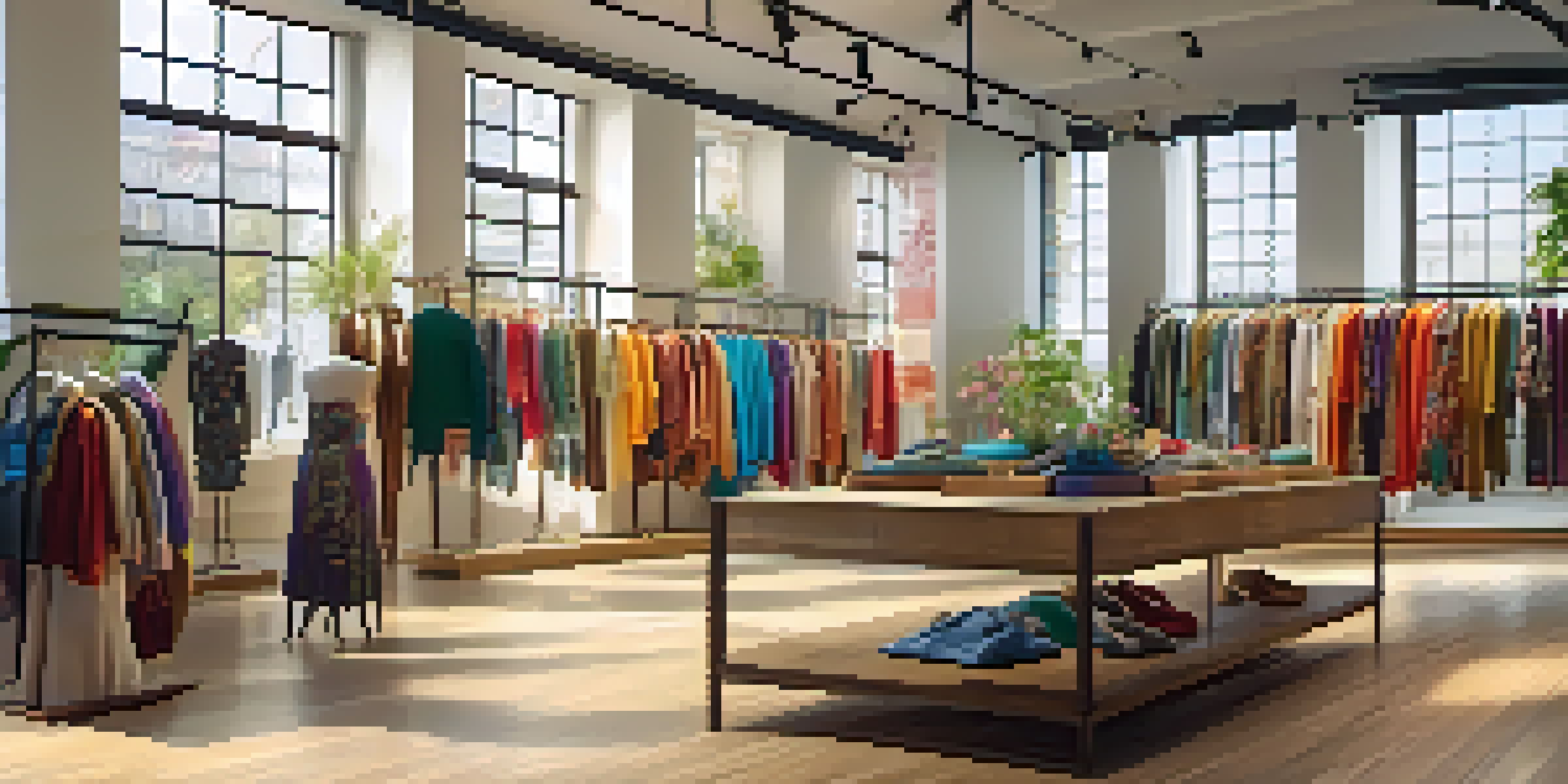Fashion Industry and Global Economic Trends: A 2024 Outlook

The Intersection of Fashion and Global Economics
The fashion industry is deeply intertwined with global economic trends, influencing everything from production to consumer spending. As economies fluctuate, brands must adapt to changing consumer behaviors and economic conditions. For instance, during economic downturns, consumers often prioritize value over luxury, prompting brands to rethink their pricing strategies.
Fashion is the armor to survive the reality of everyday life.
In 2024, we expect to see a stronger push for sustainability, driven by both ethical consumerism and economic necessity. Brands are increasingly aware that eco-friendly practices can lead to cost savings and attract a growing demographic of environmentally conscious shoppers. This shift not only addresses consumer concerns but also aligns with broader economic trends towards sustainable growth.
Furthermore, the rise of digital commerce is reshaping how fashion brands operate globally. With online shopping becoming the norm, brands are investing in e-commerce platforms and digital marketing strategies to reach consumers worldwide. This transition not only opens up new markets but also presents challenges in logistics and supply chain management.
Consumer Behavior Shifts in 2024
As we move into 2024, consumer behavior in the fashion industry is evolving rapidly due to various economic factors. Inflation and financial uncertainty have made consumers more deliberate in their purchasing decisions, leading to a rise in second-hand shopping and rental services. This trend reflects a broader shift towards valuing experiences and sustainability over fast fashion.

Moreover, the influence of social media continues to shape consumer preferences. Platforms like Instagram and TikTok drive trends, encouraging brands to engage with their audience through authentic storytelling and influencer collaborations. This shift highlights the importance of building a community around a brand, rather than just selling products.
Sustainability Drives Fashion Change
In 2024, sustainability is becoming essential as brands adopt eco-friendly practices to meet consumer demand for transparency and ethical production.
Brands are now focusing on personalization and customer experience to foster loyalty and repeat business. By leveraging data analytics, companies can tailor their offerings to meet individual preferences, making shopping more enjoyable and relevant for consumers. This shift not only caters to consumer desires but also enhances brand value in a competitive market.
Sustainability and Ethical Practices in Fashion
Sustainability has become a buzzword in the fashion industry, but in 2024, it's evolving into a necessity. With consumers increasingly demanding transparency, brands are being held accountable for their environmental impact. This year, we anticipate a surge in sustainable practices, from eco-friendly materials to ethical labor practices, as companies strive to meet these expectations.
Sustainability is not a trend; it is a necessity for our industry and our planet.
The rise of circular fashion is a significant trend that emphasizes recycling and reuse. Brands are exploring innovative ways to repurpose materials and reduce waste, promoting a closed-loop system. For example, some companies are launching take-back programs that encourage customers to return old garments for recycling or refurbishment.
Moreover, collaborations between brands and environmental organizations are becoming more common. These partnerships not only enhance a brand's credibility but also contribute to meaningful change in the industry. By working together, brands can tackle pressing environmental issues more effectively and create a positive impact.
Technology's Role in Fashion Innovation
Technology is revolutionizing the fashion industry, and 2024 is set to be a landmark year for innovation. From artificial intelligence to augmented reality, brands are utilizing cutting-edge technologies to enhance the shopping experience and streamline operations. For instance, virtual fitting rooms are becoming increasingly popular, allowing customers to try on clothes digitally before making a purchase.
Moreover, the integration of blockchain technology is gaining traction, providing transparency in supply chains. This technology allows consumers to trace the origin of their clothing, ensuring ethical sourcing and authenticity. As consumers become more aware of the impacts of their choices, brands that adopt these technologies will likely gain a competitive edge.
Consumer Behavior Shifts Online
As inflation and uncertainty grow, consumers are increasingly turning to second-hand shopping and rental services, prioritizing value and sustainability.
Additionally, data analytics is transforming how brands understand and predict fashion trends. By analyzing consumer behavior and preferences, companies can make informed decisions about product development and marketing strategies. This data-driven approach not only enhances efficiency but also aligns product offerings with consumer demand.
Global Supply Chain Challenges Ahead
The fashion industry is still grappling with supply chain challenges that were exacerbated by the pandemic. In 2024, brands must navigate issues like shipping delays, rising material costs, and labor shortages. These challenges require companies to rethink their supply chain strategies and consider local sourcing to mitigate risks and reduce carbon footprints.
Moreover, geopolitical tensions can also impact the fashion supply chain. As countries impose tariffs or trade restrictions, brands may need to adjust their sourcing strategies to maintain profitability. This shifting landscape emphasizes the importance of agility and flexibility in supply chain management.
To address these challenges, many brands are investing in technology and automation to streamline operations. By embracing advanced logistics solutions, companies can enhance efficiency and reduce costs, ultimately benefiting consumers. As the industry adapts to these global shifts, resilience will be key in maintaining a competitive edge.
Diversity and Inclusion in Fashion
Diversity and inclusion have become essential topics within the fashion industry, and 2024 is no exception. Consumers are increasingly advocating for representation in fashion, prompting brands to diversify their marketing strategies and product offerings. This year, we expect to see more brands embracing inclusivity by showcasing diverse models and styles that cater to a wider audience.
Moreover, brands are also recognizing the importance of cultural sensitivity in their designs and marketing campaigns. By collaborating with diverse creatives, companies can develop collections that resonate with various cultural backgrounds, fostering a sense of belonging among consumers. This approach not only enhances brand credibility but also drives engagement and loyalty.
Tech Innovations Transform Retail
Technological advancements like AI and blockchain are revolutionizing fashion, enhancing shopping experiences and providing transparency in supply chains.
Ultimately, embracing diversity goes beyond aesthetics; it reflects a brand's values and commitment to social responsibility. As consumers continue to demand change, brands that prioritize inclusivity will likely thrive in the competitive fashion landscape of 2024.
The Future of Fashion Retail: Adapt or Die
The future of fashion retail hinges on adaptability, with 2024 presenting both challenges and opportunities. Traditional retail models are evolving, as consumers shift towards online shopping and expect seamless, omnichannel experiences. Brands that fail to adapt to these changing consumer preferences risk losing relevance in an ever-competitive market.
Moreover, experiential retail is gaining momentum, as brands seek to create memorable shopping experiences that go beyond mere transactions. By offering unique in-store experiences or virtual events, companies can engage consumers and foster brand loyalty. This trend highlights the importance of innovation in attracting and retaining customers.

As we look ahead, collaboration within the industry will be critical for success. By partnering with other brands, technology providers, and influencers, fashion companies can leverage shared resources and knowledge to navigate the evolving landscape. The ability to adapt and collaborate will ultimately define the future of fashion retail in 2024.